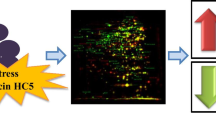Abstract
This study was conducted to investigate the antibacterial effect of BSAP-254 on Bacillus cereus with the induced stress proteins. The BSAP-254 is an antimicrobial peptide isolated from soybean-fermenting bacteria, Bacillus subtilis SC-8. It had a narrow spectrum of activity against B. cereus group. The growth inhibitory effect of BSAP-254 (50 μg/mL) reduced the population of B. cereus from >108 to 104 colony-forming units per milliliter within 30 min. In B. cereus exposed to BSAP-254, 14 intracellular proteins were differentially expressed as determined by 2-DE coupled with MS. Of the differentially expressed proteins identified, the stress protein GroEL, which is heat shock protein, was induced in B. cereus exposed to antibacterial peptide.


Similar content being viewed by others
References
Raso, J., Góngora-Nieto, M. M., Barbosa-Cánovas, G. V., & Swanson, B. G. (1998). International Journal of Food Microbiology, 44, 125–132.
Rowan, N. J., MacGregor, S. J., Anderson, J. G., Fouracre, R. A., McIlvaney, L., & Farish, O. (1999). Applied and Environmental Microbiology, 65, 1312–1315.
Kim, C., Hung, Y. C., & Brackett, R. E. (2000). International Journal of Food Microbiology, 61, 199–207.
Coroller, L., Leguerinel, I., & Mafart, P. (2001). Applied and Environmental Microbiology, 67, 317–322.
Valero, M., Sarrías, J. A., Alvarez, D., & Salmerón, M. C. (2006). Food Microbiology, 23, 367–371.
Cho, M., Choi, Y., Park, H., Kim, K., Woo, G. J., & Park, J. (2007). Journal of Food Protection, 70, 97–101.
Akbas, M. Y., & Ozdemir, M. (2008). Food Microbiology, 25, 386–391.
Pol, I. E., van Arendonk, W. G., Mastwijk, H. C., Krommer, J., Smid, E. J., & Moezelaar, R. (2001). Applied and Environmental Microbiology, 67, 1693–1699.
Park, Y. B., Guo, J. Y., Rahman, S. M., Ahn, J., & Oh, D. H. (2009). Journal of Food Science, 74, M185–M189.
Cladera-Olivera, F., Caron, G. R., & Brandelli, A. (2004). Letters in Applied Microbiology, 38, 251–256.
Kim, P. I., Bai, H., Bai, D., Chae, H., Chung, S., Kim, Y., et al. (2004). Journal of Applied Microbiology, 97, 942–949.
Straus, S. K., & Hancock, R. E. W. (2006). Biochimica et Biophysica Acta, 1758, 1215–1223.
Sieprawska-Lupa, M., Mydel, P., Krawczyk, K., Wójcik, K., Puklo, M., Lupa, B., et al. (2004). Antimicrobial Agents and Chemotherapy, 48, 4673–4679.
Campos, M. A., Vargas, M. A., Regueiro, V., Llompart, C. M., Albertí, S., & Bengoechea, J. A. (2004). Infection and Immunity, 72, 7107–7114.
Gatzeva-Topalova, P. Z., May, A. P., & Sousa, M. C. (2005). Biochemistry, 44, 5328–5338.
Fehri, L. F., Sirand-Pugnet, P., Gourgues, G., Jan, G., Wróblewski, H., & Blanchard, A. (2005). Antimicrobial Agents and Chemotherapy, 49, 4154–4165.
Lee, N. K., Yeo, I. C., Park, J. W., Kang, B. S., & Hahm, Y. T. (2010). Journal of Bioscience and Bioengineering, 110, 298–303.
Sivapathasekaran, C., Mukherjee, S., Samanta, R., & Sen, R. (2009). Analytical and Bioanalytical Chemistry, 395, 845–854.
Lee, S. K., Kim, Y., Kim, S. S., Lee, J. H., Cho, K., Lee, S. S., et al. (2009). Proteomics, 9, 4389–4405.
Stein, T. (2005). Molecular Microbiology, 56, 845–857.
Morikawa, M., Hirata, Y., & Imanaka, T. (2000). Biochimica et Biophysica Acta, 1488, 211–2118.
Zhang, L., Dhillon, P., Yan, H., Farmer, S., & Hancock, R. E. (2000). Antimicrobial Agents and Chemotherapy, 44, 3317–3321.
Chen, H., Wang, L., Su, C. X., Gong, G. H., Wang, P., & Yu, Z. L. (2008). Letters in Applied Microbiology, 47, 180–186.
Narberhaus, F. (1999). Molecular Microbiology, 31, 1–8.
Periago, P. M., van Schaik, W., Abee, T., & Wouters, J. A. (2002). Applied and Environmental Microbiology, 68, 3486–3495.
Acknowledgments
This research was supported by Basic Science Research Program through the National Research Foundation of Korea (NRF) funded by the Ministry of Education, Science and Technology (no. 2009–0073489).
Author information
Authors and Affiliations
Corresponding author
Rights and permissions
About this article
Cite this article
Lee, N.K., Yeo, IC., Park, J.W. et al. Growth Inhibition and Induction of Stress Protein, GroEL, of Bacillus cereus Exposed to Antibacterial Peptide Isolated from Bacillus subtilis SC-8. Appl Biochem Biotechnol 165, 235–242 (2011). https://doi.org/10.1007/s12010-011-9246-7
Received:
Accepted:
Published:
Issue Date:
DOI: https://doi.org/10.1007/s12010-011-9246-7




